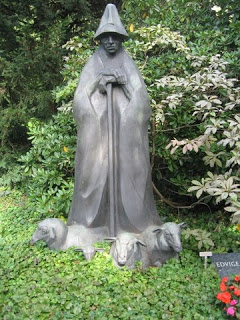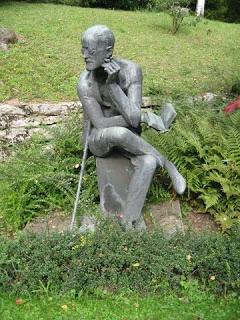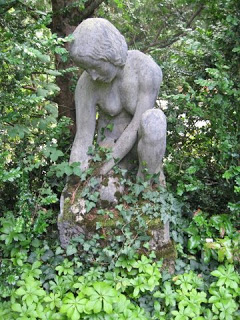Graveyards, James Joyce, Heaventalk
I have always loved graveyards. Old ones, with lichen on the tilting stones, overgrown edges and tall twisted trees are my favorite. In Massachusetts the earliest gravestones are carved with hourglasses, death’s heads, coffins, imps, dragons, and intricately caved vines and fruit. In Paris the cemeteries are called Cities of the Dead, and are, in fact, laid out like small cities, with tidy streets and squares, the mausoleums like dolls’ houses. In the Passy Cemetary in Paris (one of my favorites) there is a mausoleum wherein a Russian poet placed a Persian carpet, a long wooden tables, candelabra and a large oil painting of a grieving woman dressed in black. In the Jewish part of any cemetery, small stones placed on the headstones indicate someone has visited, and this makes great sense to me, since in First Nations culture the grandfather stones carry the memory of the people. In the Moroccan deserts bodies are buried under rough piles of stones, with plaques leaned up against them. They seem to long for the desert winds which will come and soon bury them under sand, a testament to the transience of all things. Insh’allah.
I have always wanted to live next to a graveyard. I think the dead would make lovely, quiet neighbors and I am most curious as to what sorts of dreams one would have there. Loren Eisley, the great essayist-poet once asked, “Does anyone who goes to a graveyard alone ever really expect to return?” Well, I would say yes, but not unchanged.
In every city I visit, I try and stop into at least one cemetery and visit the ancestors. Here in Zurich, I am introduced to some very fancy folks indeed. The graveyard, where I have come to find the graves of James Joyce and Elias Canetti, is up above the prosperous bankers’ city, right near the zoo. Apparently Nora Barnacle, James’s wife, thought this was the perfect place for her husband’s eternal rest, since he’d be able to hear the lions’ roar from here. I think I would have liked Nora.
I met with an acquaintance, Terri Martin, an Australian now living part of the time in Zurich and part of the time in England. She writes screenplays and has a wonderful easy laugh, making her great company. We took the number 6 tram up the side of the mountain, past the bustling university district, to the rich and rarified neighborhood near the zoo. In my previous post, I mentioned that the concierge at my hotel (a young woman no older than twenty-five) had looked at me with alarming blankness when I’d asked about James Joyce. Happily, as we step off the tram and I ask an older lady if she can direct us to the cemetery, my faith in literary intelligence is restored when her face lights up and she says, “Ah, yes, of course – James Joyce, I think?” James Joyce indeed. She directs us to a nondescript metal gate fifty feet beyond the tram stop.
The cemetery is terribly tidy and orderly, as one would expect of Switzerland. (I have a Swiss friend who says, “We Swiss don’t have more laws that other countries, it’s simply that we enforce every single one of them.”) Three men prune shrubs and trim plants and deadhead (you’ll pardon the pun) the roses. The cemetery is surrounded by trees, which rather blocks the stupendous view of the lake below, but I don’t suppose the residents mind much. A funeral is going on a few rows away, with a group of perhaps a dozen people, mostly women, all dressed in black and white. They don’t seem terribly grief-stricken, however, and as we pass by, we notice they are laughing, as though someone has just told a well-known joke about the recently deceased. Although there are no mausoleums here (perhaps that would be considered a bit showy – this is the heart of reformation Calvinism), an astonishing number of the graves boast stunning sculptures, some modern, some traditional – angles, lambs and so forth.

We walk along a well-groomed path and then find a little sign. “Joyce. Cannetti.” And an arrow. We walk up three steps and there on the right is the Joyce family grave. A plaque lies on the carpet-like grass, indicating the names and appropriate dates for James, Nora, their son, Giorgio, and Giorgio’s second wife. Lucia, Joyce’s daughter, died in 1962 at St. Andrew’s a mental institution in Northampton, England, near which she is buried, far from the family grave. (Lucia’s tale is a tragic one, of which I may speak at another time.) Behind the place is a sculpture by American sculptor Milton Hebald, placed here on Bloomsday, 1966, twenty-five years after Joyce’s death. Even in this place of so many lovely statues, this one has distinctive charm.


Copyright 2008 Lauren B. Davis For permissions: laurenbdavis.iCopyright.com
Hi Lauren, what a most beautiful combination of writing and images, to be appreciated on Bloomsday – thank you!
As a tribute to James Joyce, I would like to contribute an old Irish song, with the wonderful voice and feeling of sandy Denny – perhaps the best female singer ever
http://www.youtube.com/watch?v=-boiaoe2tCM
Cheers Arturo
Thanks so much, Arturo! And thanks for the Sandy Denny clip. LOVE her!